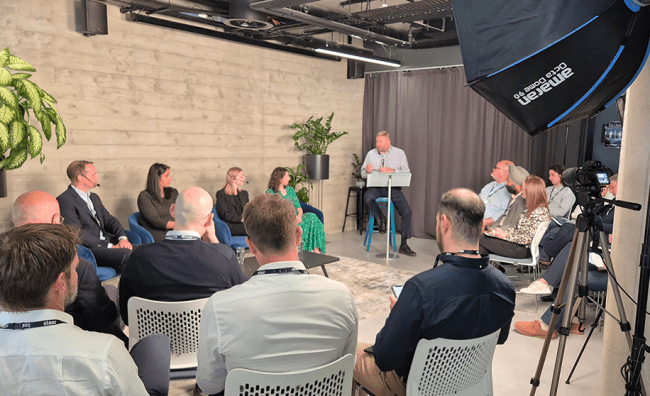Getting ready for takeoff: What is Advanced Air Mobility?
Explore how Advanced Air Mobility and eVTOLs will transform travel and urban connectivity.

Welcome to ‘Getting ready for take-off’, Steer’s series on Advanced Air Mobility (AAM). Since 2021, Steer’s infrastructure and aviation teams have been working on ridership and revenue forecasting for electric vertical take-off and landing (eVTOL) aircraft, a groundbreaking form of transit that until recently was a thing of science fiction.
Today, we know that eVTOL will soon be taking to the skies of cities across the US and the world, making journeys simpler for passengers and easing congestion on the gridlocked streets below. How many people will be riding in these aircraft? What will the price point be? And what legislation and regulatory policies will govern their introduction? These questions and more will be answered in our series. Read below to find out more.
Advanced Air Mobility (AAM), the term used to describe this emerging aviation system, has gained significant traction in the aviation and infrastructure sectors in recent years. Global investment to make AAM a reality surged to $7 billion in 2021, signaling strong industry momentum, with stakeholders including transport regulatory bodies, AAM aircraft manufacturers, vertiport and transit system operators and local and national governments.
The vision is clear: revolutionize urban mobility by creating a new transportation system that extends to commercial, regional, cargo, and emergency transit. The system would operate electric vertical takeoff and landing (eVTOL) aircraft, supported by specialized vertical landing and takeoff infrastructure known as vertiports.
By linking vertiports with public transit hubs, airports, and major business districts, AAM can enhance connectivity, reduce road congestion, and improve travel times, fundamentally transforming urban mobility.
Which US cities are already planning for AAM?
AAM has the potential to vastly improve reliable travel times in cities where journeys are marred by traffic bottlenecks.
In New York, for example, strategically placed vertiports on rooftops, near transportation centres, and airports can provide a more time-efficient travel alternative.
In Los Angeles, a city notorious for its sprawling layout and traffic jams, AAM could improve mobility by enabling point-to-point travel across the metro area in a fraction of the time required by ground transportation. AAM could also play a critical role in the 2028 Olympic Games set to be held in Los Angeles, seamlessly connecting athletes, visitors, and residents to key venues, airports, and transit centers.
Cities like Boston and Miami are also already actively incorporating AAM into their future mobility strategies. AAM presents a transformative opportunity for improving transportation across water barriers, such as lakes, rivers, and coastal regions, as well as enhancing island-to-mainland connectivity. Traditional ferry systems and bridges often experience delays and congestion, whereas eVTOL aircraft can provide a faster and more direct travel alternative.
Who are the key stakeholders in AAM?
Despite the early-stage nature of AAM, the industry is rapidly attracting attention from city planners, infrastructure developers, airports, and private investors, with several well-funded key players leading the charge in development.
Vertiport Developers / Operators
- Bluenest: A subsidiary of Globalvia, focused on designing and managing multimodal vertiports integrated with airports and urban transport hubs, alongside the development of infrastructure to access remote locations, like pilot projects undertaken in Latin America.
- Skyports: A London-based company specializing in urban vertiports, with its first operational test vertiport launched in Singapore in 2019, and invested by ACS Group. In 2024, Skyports and French airport operator Groupe AdP were selected as the preferred operator of New York City’s Downtown Manhattan Heliport.
- UrbanV: Established by Aeroporti di Roma, SAVE Group, Aeroporto di Bologna and Aeroports de la Côte d’Azur, and planning to develop vertiport networks across Europe.
- VertiPorts by Atlantic: A subsidiary of Atlantic Aviation, one of the largest FBO companies in the US, recently acquired Ferrovial Vertiports. The company operates NYC's East 34th Street Heliport.
eVTOL Manufacturers
- Archer Aviation: US-based, and planning to enter into service this year. Partnering with United Airlines.
- Beta Technologies: US-based. Currently has aircraft orders from several helicopter operators, including Blade.
- eHang: The Chinese manufacturer has been operating a single-seat eVTOL model since 2018, although it is uncertain when it will be able to obtain certification from EASA or FAA.
- Eve Air Mobility: A subsidiary of Embraer. Planning to enter into service in 2027.
- Joby Aviation: US-based and has the largest funding so far. Partnering with Delta and Uber. Planning to enter into service this year.
These firms, in partnership with public authorities, are driving the AAM vision, focusing on five key success factors. Strategic vertiport locations near transit hubs, airports, and business districts will maximize accessibility. Multimodal connectivity promotes seamless integration with buses, trains, and ridesharing. Energy and charging infrastructure must support fast-charging networks for eVTOL aircraft. Air traffic management (ATM) integration is crucial for coordinating with existing and developing aviation regulations. Finally, public perception and community engagement will be key to addressing concerns about noise, safety, and urban impact, ensuring broad acceptance of AAM as a viable transportation solution.
What’s next for AAM
As regulations evolve and technology matures, the pilot projects and test sites we see today will pave the way for broader adoption, potentially transforming urban mobility within the next decade. By 2035, we could see full-scale commercial operations in selected cities, while from 2035, global vertiport networks could be supporting mass eVTOL adoption.
Public-Private Partnerships will play a crucial role in ensuring that the public and private sectors collaborate effectively to develop AAM solutions tailored to the unique needs of each urban landscape.
The success of AAM will depend on coordinated efforts between governments, industry players, and the public. While the enabling technologies are advancing rapidly, regulatory frameworks, infrastructure development, and public perception remain key stage gates to deployment. By fostering collaboration and investing in sustainable solutions, AAM has the potential to revolutionize urban transportation, reduce congestion and provide efficient, eco-friendly travel options.
As cities continue to grow, innovative transport solutions like AAM will be crucial in shaping the future of mobility. The next decade will be critical in determining whether AAM can transition from pilot projects to a fully integrated component of urban transport networks worldwide.






















